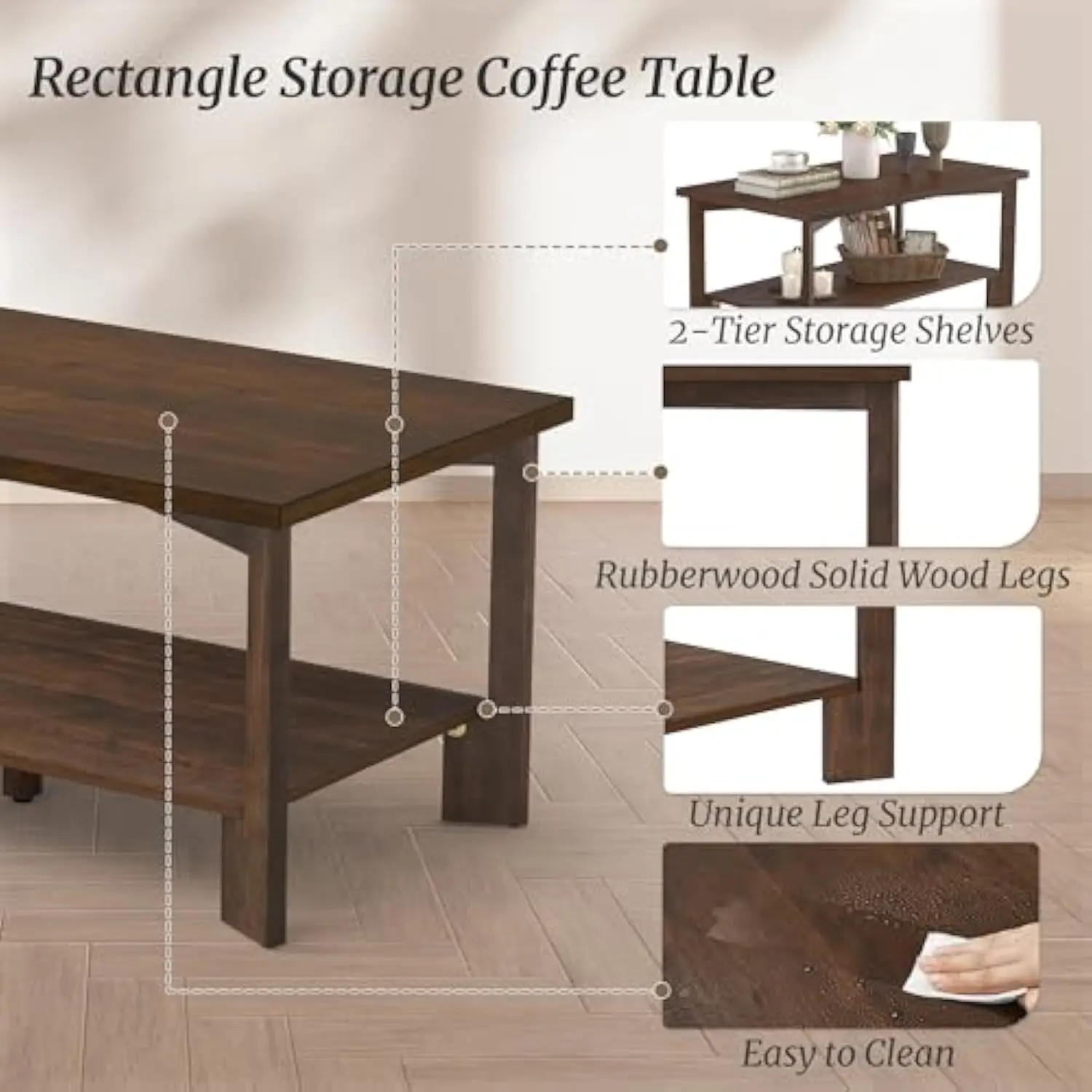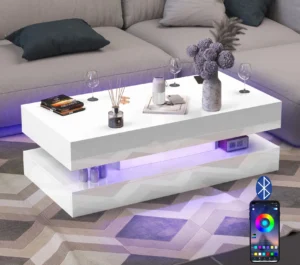Introduction to Coffee Table Shapes: Why Your Choice Matters
The coffee table stands as both the functional workhorse and visual anchor of your living room. Far more than just a place to rest your mug or display a few books, this piece of furniture silently orchestrates how people move, gather, and interact within your space.
The shape you choose—rectangular or square—affects everything from traffic flow to conversation dynamics. This decision extends beyond mere aesthetic preference into practical considerations that impact daily life. In the tradition of mid-century modern design, where form follows function, your coffee table should serve as a piece of functional art that complements your lifestyle.
The principles behind rectangular coffee table design features demonstrate how shape influences both utility and visual impact. Understanding these relationships helps you make an informed choice that enhances your living space rather than simply filling it.
Whether you’re furnishing a new home or refreshing your current space, the following comparison will guide you through the factors that matter most when deciding between these two classic shapes.
Essential Coffee Table Guidelines: Size, Height, and Placement
Before comparing rectangular and square options, let’s establish some universal guidelines that apply to all coffee tables regardless of shape:
- The Two-Thirds Rule: Your coffee table should be approximately two-thirds the length of your sofa for balanced proportions.
- Height Harmony: The ideal coffee table sits within 1-2 inches of your sofa seat height (typically 16-18 inches from the floor).
- Clearance Requirements: Maintain 14-18 inches (35-45 cm) between your table and seating to allow comfortable leg room while keeping the table within easy reach.
- Scale Consideration: The table should feel proportional to surrounding furniture—neither overwhelmingly large nor insignificantly small.
Following these principles ensures your coffee table maintains visual harmony and functional comfort in your room. The proper implementation of these rules creates a cohesive look regardless of whether you choose a rectangular or square design.
Finding ideal square coffee table dimensions becomes much easier when you start with these foundational principles and then adapt them to your specific space requirements.
Rectangular Coffee Tables: The Classic Choice
The rectangular coffee table represents the traditional choice in living room design, and for good reason. Its elongated shape naturally complements the standard linear arrangement of sofas and seating areas found in most homes.
Rectangular tables have maintained their popularity through various design trends because they efficiently utilize space in conventional room layouts. Their proportions often mirror the shape of the room itself and the primary seating pieces, creating visual cohesion.
In mid-century modern design, rectangular coffee tables exemplify clean lines and purposeful form. Their streamlined geometry provides ample surface area while maintaining visual lightness—a perfect embodiment of the “less is more” principle that defines this enduring design movement.
The distinctive key design traits of rectangular coffee tables include their ability to guide eye movement across the room while providing well-defined zones for both function and display. For a wide selection of options that embody these principles, explore our mid-century modern rectangular coffee tables collection.
Pros of Rectangular Coffee Tables
Versatile Proportions: Rectangular tables work exceptionally well with standard sofas and traditional room layouts, creating natural visual harmony with the most common furniture arrangements.
Maximum Surface Area: The extended length provides more usable space for books, trays, and decorative objects while still allowing items to be within arm’s reach from multiple seating positions.
Traffic Flow Management: The longer shape naturally creates pathways around the living space, guiding movement patterns and helping define the conversation area from transit spaces.
Storage Potential: Many rectangular designs offer more room for incorporated drawers, shelves, or hidden compartments without appearing bulky or disrupting the table’s lines.
Visual Balance: These tables create pleasing proportions with longer sofas and similarly rectangular rooms, extending the eye across the space in a way that feels natural and intentional.
Transforming room layout with rectangular coffee tables can significantly impact how people use and experience your space, making this shape particularly effective in rooms that need clear directional flow.
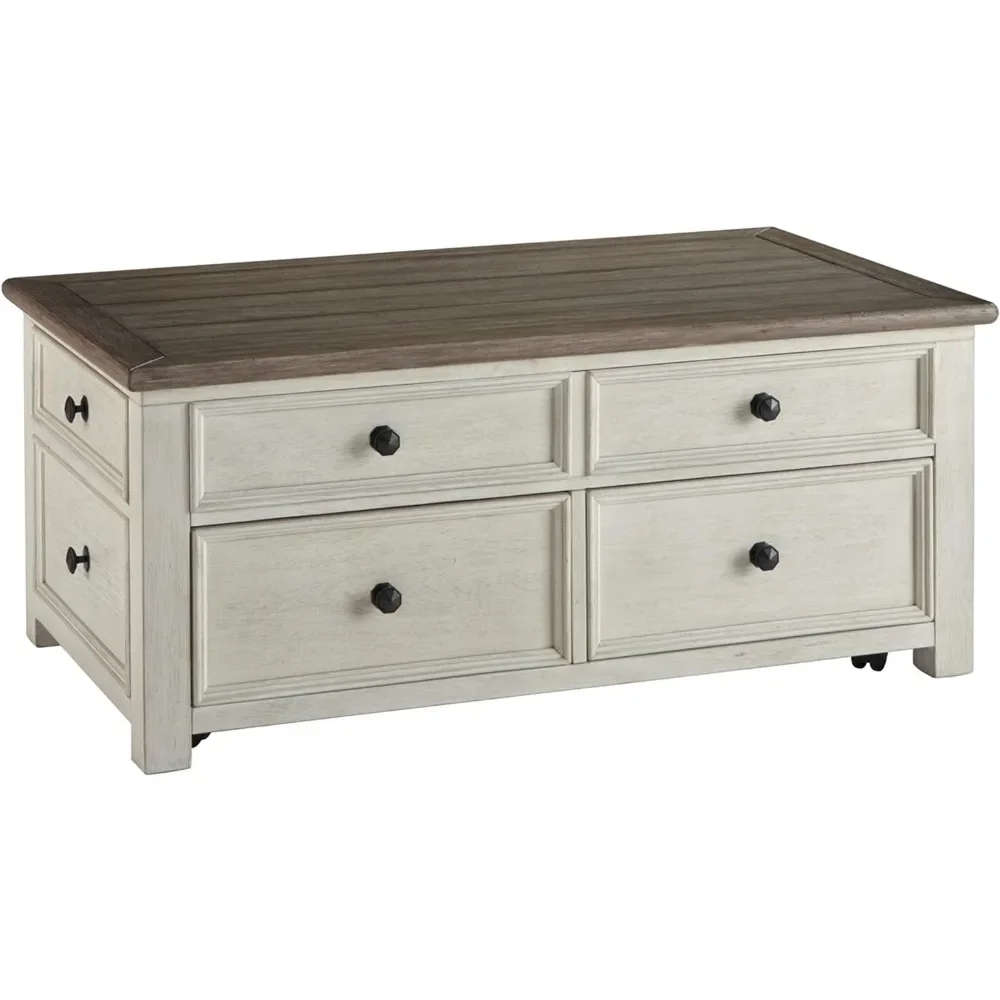
Cons of Rectangular Coffee Tables
Space Requirements: In smaller rooms, rectangular tables can sometimes overwhelm the space or create awkward traffic patterns, particularly if the room itself lacks sufficient width.
Safety Concerns: The four corners present potential hazards, especially in homes with young children or in high-traffic areas where people frequently move around the table.
Less Inclusive for Conversation: People seated at opposite ends of a long sofa may find a rectangular table creates more distance between them, potentially making conversation less intimate.
Can Create Dead Space: In certain room configurations, the areas at the narrow ends of the table may become awkward dead zones that don’t align well with seating positions.
Less Effective with Sectionals: The straight lines of rectangular tables often don’t complement the angular arrangement of L-shaped seating as naturally as other shapes might.
For alternatives that address some of these limitations while maintaining a linear form, consider the comparison between oval vs rectangular coffee tables, which explores how softened corners can mitigate certain drawbacks.
Square Coffee Tables: The Contemporary Contender
Square coffee tables have gained significant popularity in contemporary design for their perfect symmetry and balanced proportions. These tables create a sense of ordered harmony that appeals to modern sensibilities.
The equal sides of a square table project a confident stability in your space, making them particularly well-suited for central placement with seating arranged around all four sides. This shape encourages a more democratic conversation area where everyone has equal access to the table.
Square tables embody key mid-century modern principles through their clean geometry and functional symmetry. Their form creates a strong visual anchor without unnecessary embellishment—letting quality materials and craftsmanship take center stage.
For spaces that would benefit from this balanced approach, our mid-century modern square coffee tables collection offers designs that combine this perfect symmetry with authentic mid-century character.
Pros of Square Coffee Tables
Perfect for Sectionals: Square tables naturally complement the angle of L-shaped sectional sofas, filling the corner space effectively while remaining accessible from both sides.
Promotes Conversation: The equidistant design creates equal access from multiple seating positions, fostering more inclusive social interaction around the table.
Visual Symmetry: Square tables bring a sense of balance and order to a room, particularly effective in square rooms or when surrounded by modular or symmetrically arranged furniture.
Versatility in Placement: Their even proportions allow them to be easily centered in conversation areas, creating a more cohesive gathering space that feels intentionally designed.
Space Efficiency: In defined seating groupings, square tables often use space more efficiently without extending unnecessarily into walkways or beyond the natural conversation zone.
The definitive guide to advantages of square coffee tables explores these benefits in greater depth, helping you understand when this shape offers the optimal solution for your specific arrangement.
Cons of Square Coffee Tables
Limited Surface Length: Square tables may not provide adequate reach along longer sofas, potentially leaving people seated at the ends reaching uncomfortably far for items.
Proportion Challenges: In very long or narrow rooms, square tables can look awkward or unbalanced, creating a visual disconnect with the room’s natural proportions.
Still Has Sharp Corners: While often less problematic than rectangular tables (simply due to having fewer corners), square tables still present safety concerns with their four 90-degree angles.
Scale Requirements: Smaller square tables can look insignificant in larger spaces, while larger square tables may overwhelm more modest rooms—finding the right balance is crucial.
Less Traditional: Square coffee tables may not complement classic furniture arrangements as naturally as rectangular options, potentially creating visual tension in more traditional settings.
When considering alternatives for specific seating arrangements, the comparison between round or square coffee tables for sectionals can provide valuable insights into which shape might better serve your particular layout.
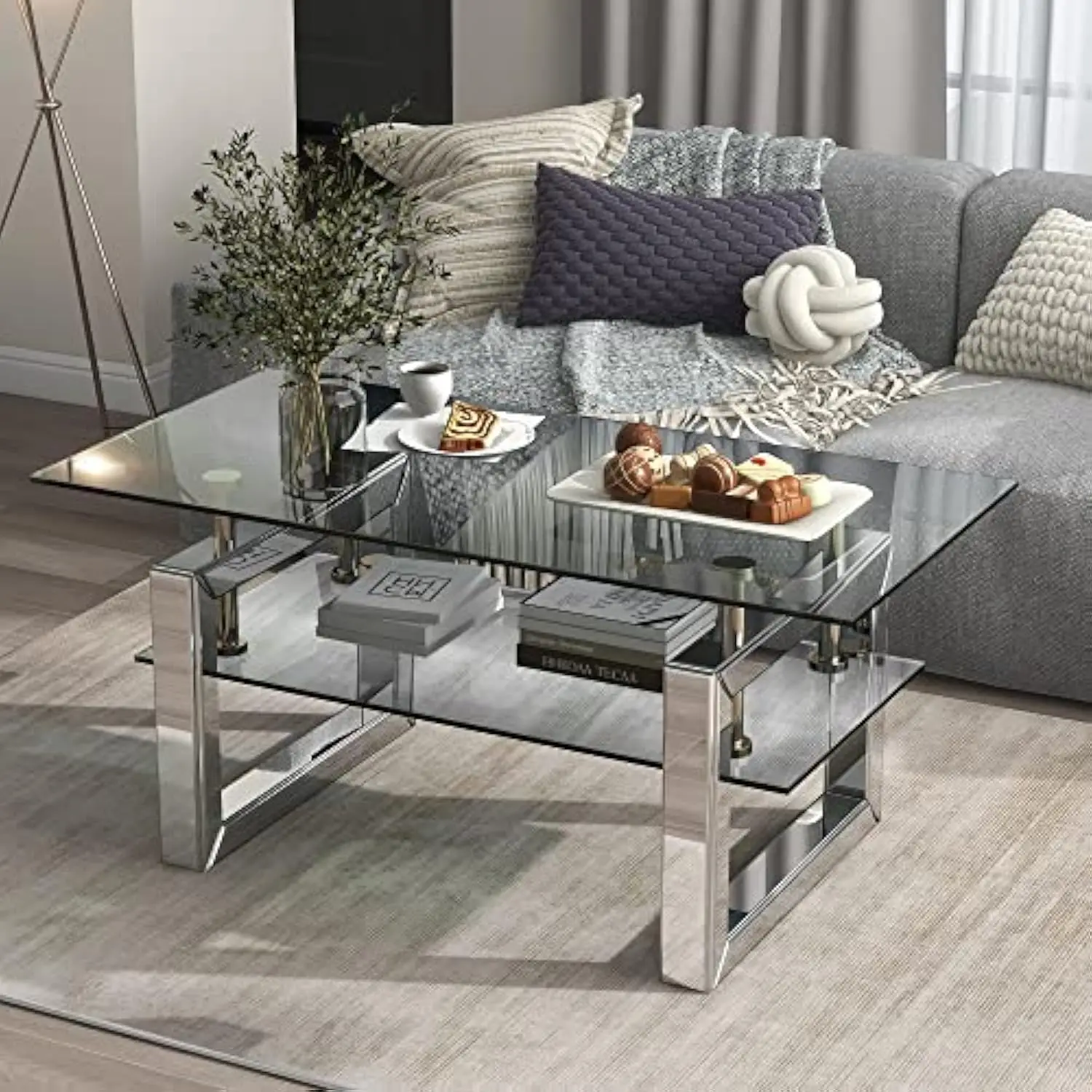
Direct Comparison: Room Size and Layout Considerations
| Room Configuration | Recommended Shape | Reasoning |
|---|---|---|
| Small/compact living rooms | Square | Maximizes space efficiency without extending into walkways |
| Large open-plan spaces | Rectangular | Helps define and anchor specific conversation areas |
| Long, narrow rooms | Rectangular | Complements the room’s natural proportions |
| Square rooms | Square | Creates visual harmony with the room’s equal dimensions |
| Open concept spaces | Either | Depends on how you want to define functional zones |
For larger spaces where rectangular tables are particularly effective, mastering space planning with long rectangular tables can help you maximize their potential without disrupting the flow of your space.
Matching Table Shape to Your Seating Arrangement
Standard Three-Seater Sofa: Rectangular tables typically work best, mirroring the sofa’s linear shape and providing access along the entire seating area.
L-Shaped Sectionals: Square tables excel here, fitting naturally into the corner created by the sectional while remaining equally accessible from both wings.
U-Shaped Sectionals: Square tables create a balanced focal point within the U, though larger rectangular tables can work if properly centered.
Sofa with Chaise Lounge: Rectangular tables complement this arrangement, particularly when aligned with the main sofa section rather than the chaise.
Multiple Sofas/Conversation Areas: Rectangular tables work well between parallel sofas, while square tables better serve arrangements where seating surrounds the table on multiple sides.
For alternatives beyond the rectangular-square dichotomy, the comparison between round vs rectangle coffee tables offers insights into how curved shapes might better serve certain seating configurations.
How Function and Lifestyle Affect Your Choice
Entertainment Needs
Your entertaining style significantly impacts which table shape serves you best. Rectangular tables offer more surface area for serving multiple guests, while square tables create a more intimate setting where everyone can reach the center equally—ideal for board games or shared appetizers.
Family Considerations
Households with young children might prefer tables with rounded corners or might choose a smaller square table over a long rectangular one to minimize collision hazards. Consider how your table will withstand the demands of family life and whether features like rounded corners or soft materials might be beneficial.
Display and Storage
If your coffee table serves primarily as a display surface for books or decorative objects, consider how your items will arrange on different shapes. Rectangular tables often allow for more organized, linear arrangements, while square tables create more centralized displays.
Flexibility Requirements
Spaces that need to adapt to different uses might benefit from nesting tables or convertible designs. Both rectangular and square tables are available with functional features like lift-tops, adjustable heights, or expanding surfaces.
Mid-century modern lift-top coffee tables offer enhanced utility regardless of shape, allowing your table to transform for different activities.
Mid-Century Modern Solid Wood Coffee Tables, Mid-Century Modern Teak Coffee Tables
$879.95 Select options This product has multiple variants. The options may be chosen on the product pageMid-Century Modern Danish Coffee Tables, Mid-Century Modern Oval Coffee Tables, Mid-Century Modern Solid Wood Coffee Tables
$390.05 Select options This product has multiple variants. The options may be chosen on the product pageMid-Century Modern Glass Top Coffee Tables, Mid-Century Modern Glass Top Side & End Tables
$460.58 Select options This product has multiple variants. The options may be chosen on the product pageMid-Century Modern Glass Top Coffee Tables, Mid-Century Modern Vintage Coffee Tables, Mid-Century Modern Vintage Side & End Tables
$725.36 Select options This product has multiple variants. The options may be chosen on the product pageMid-Century Modern Lift Top Coffee Tables, Mid-Century Modern Square Coffee Tables
$454.73 Select options This product has multiple variants. The options may be chosen on the product pageMid-Century Modern Large Coffee Tables, Mid-Century Modern Rectangular Coffee Tables
$603.26 Select options This product has multiple variants. The options may be chosen on the product page
Material and Design: Enhancing Your Shape Choice
The materials you choose can significantly impact how a coffee table’s shape is perceived in your space. Glass tops create visual lightness that can make larger tables feel less imposing, while solid wood surfaces bring warmth and substance to either shape.
Design details like tapered legs, beveled edges, or mixed materials can mitigate potential drawbacks of either shape. For example, a rectangular table with rounded corners addresses safety concerns, while a square table with an interesting base draws attention away from its potentially blocky proportions.
Mid-century design principles encourage honest use of materials that showcase natural beauty and craftsmanship. Both rectangular and square tables benefit from this approach, with wood grain patterns, organic details, and quality construction enhancing their presence.
Our collection of solid wood coffee tables demonstrates how natural materials elevate both rectangular and square designs through authentic craftsmanship and timeless appeal.
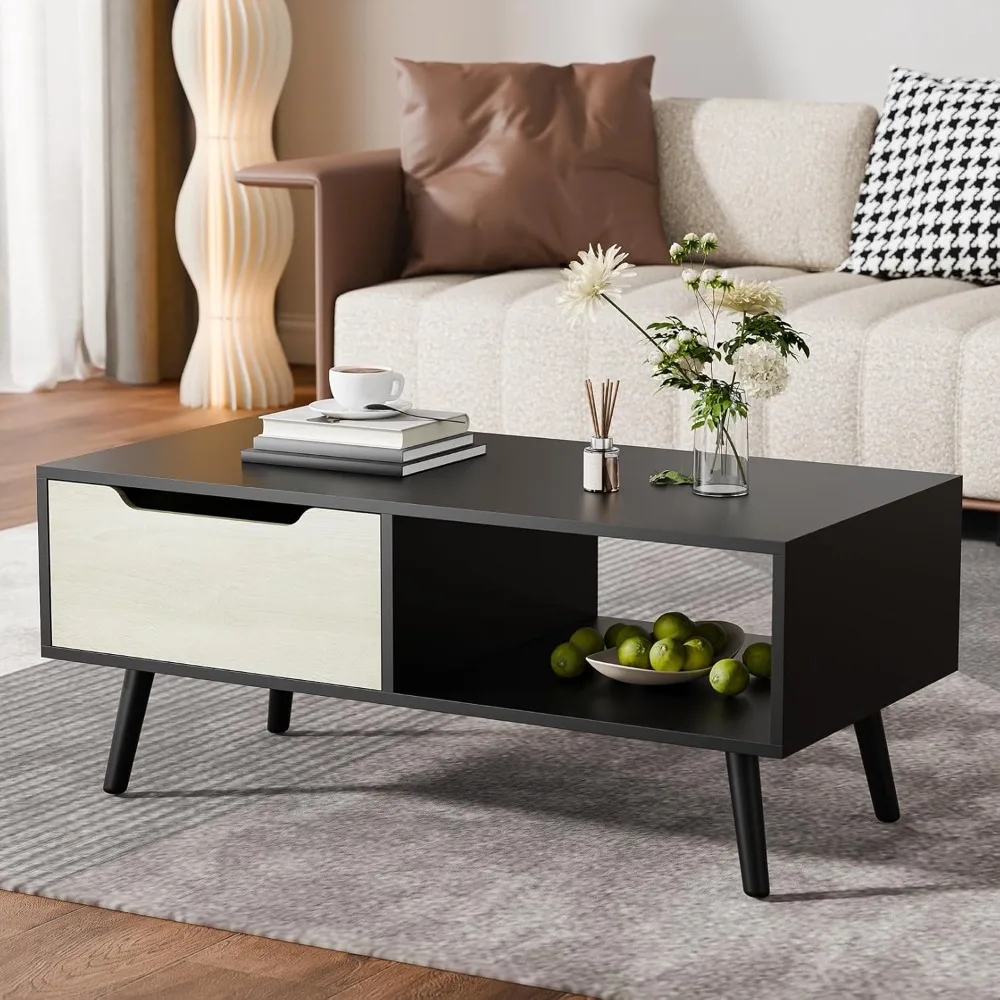
Decision Making Framework: Finding Your Perfect Table
Follow these steps to determine which coffee table shape best suits your needs:
- Measure your space – Document the dimensions of your room and seating area
- Analyze your traffic patterns – Observe how people naturally move through your room
- Consider your primary use – Determine whether you need surface area, conversation facilitation, or display space
- Evaluate your seating arrangement – Note whether your furniture is linear, L-shaped, or arranged in a conversation group
- Assess your aesthetic direction – Determine whether your style leans traditional (often favoring rectangular) or contemporary (often embracing square)
Remember that the perfect coffee table balances form and function—serving your practical needs while enhancing your room’s visual appeal. The process of choosing the perfect coffee table involves considering all these factors holistically rather than focusing on just one aspect.
Supplemental Content: Beyond the Basic Shapes
While rectangular and square tables dominate the market, other options might better serve particular spaces:
- Round tables eliminate corner safety concerns entirely and promote more fluid traffic flow
- Oval tables combine the length advantage of rectangles with the safety benefits of rounded edges
- Nested tables provide flexibility for different activities and can be separated as needed
- Clustered small tables can replace one larger table for ultimate adaptability
For spaces that benefit from versatile solutions, nesting coffee tables offer multiple surfaces that can be reconfigured as your needs change—combining the best qualities of different shapes in one adaptable set.
Does a Rectangular Table Make a Room Look Bigger?
Yes, a rectangular coffee table can make a room appear larger, particularly in narrow spaces. The elongated shape draws the eye along its length, creating an illusion of extended space. This effect works best when the rectangular table is aligned with the room’s longest dimension, essentially “stretching” visual perception.
However, this space-expanding effect only works when the table is appropriately sized for the room. An oversized rectangular table can actually make a space feel cramped. Techniques for styling rectangular coffee tables can enhance this space-expanding quality through thoughtful arrangement of objects that maintain visual flow.
Which Materials Best Complement Each Coffee Table Shape?
For Rectangular Tables:
* Solid woods with visible grain that emphasizes length
* Glass tops to reduce visual weight in smaller spaces
* Mixed materials (wood with metal accents) for dimensional interest
For Square Tables:
* Striking stone or concrete for bold geometric presence
* Richly figured wood for central focus
* Glass tops with interesting bases to lighten visual weight
Our collection of glass-top coffee tables works beautifully in both rectangular and square formats, allowing the beauty of expertly crafted bases to take center stage while maintaining a sense of openness in your space.
Ultimately, the perfect coffee table combines the right shape for your space with materials that complement your existing décor and meet your practical needs. By considering all aspects—from room layout to lifestyle requirements—you’ll find a piece that serves as both functional tool and design statement for years to come.

